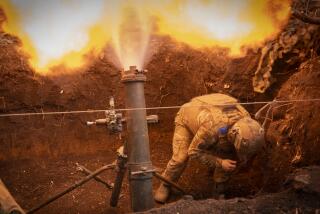Tokyo Finds Military Cuts Difficult to Match : Defense: While other nations downsize, Japan’s new peacekeeping role and its neighbors’ growing arsenals allow for little drawdown.
- Share via
TOKYO — While arms makers in other industrialized nations struggle for survival amid post-Cold War defense cuts, Japan’s weapons makers are hardly missing a beat.
Less threatening times and a prolonged recession have prompted Japan to trim the growth of its defense budget. But with North Korea suspected of developing nuclear weapons and Japan’s neighbors rapidly expanding their conventional arsenals, cutbacks are cautious and limited.
“Given these factors, and Japan’s new peacekeeping role, it is difficult to scale down,” says Masayuki Mochizuki, an analyst at W.I. Carr in Tokyo.
Japan contributed $13 billion to the allied effort in the Gulf War. Last year, after Parliament approved the creation of a 2,000-member corps to participate in U.N. peacekeeping operations, Tokyo sent 600 ground troops to Cambodia, although they are limited to non-combat duty.
Defense spending in fiscal 1993 is expected to rise 1.95% to $41.8 billion at the current exchange rate in fiscal 1993, which began on April 1.
That’s the lowest growth rate in 33 years, although Japan’s military spending still ranks among the top six in the world, partly because of the substantial sums it spends to help support the 40,000 U.S. military personnel stationed in the country.
“I don’t think Japan would cut its defense spending just because other nations do,” says Yutaka Hineno, managing director at Mitsubishi Heavy Industries, the country’s leading defense contractor. “Defense capability can’t be resurrected overnight when the necessity arises.”
The size and structure of Japan’s defense industry also cushion it from the kinds of shocks felt by weapons makers in the United States, where defense cuts may eliminate at least a million jobs by 1997, including 594,000 in manufacturing, according to the U.S. Labor Department.
Japan’s constitution limits its military to a purely defensive role, and defense spending has customarily been kept to no more than 1% of the nation’s gross national product. In the United States, defense spending amounts to 5.4% of GNP.
Japan bans weapons exports, with the exception of limited technology exchanges with the United States.
The biggest defense sector is military aerospace, which accounts for about 70% of all aerospace production, according to industry figures. The sector is getting a boost from development of the FSX fighter, a joint effort between Mitsubishi Heavy Industries and Lockheed Corp.
The FSX is on schedule for initial flights in 1995, according to Hineno.
While the Cold War led to the creation of U.S. companies entirely dependent on Pentagon contracts, for most Japanese defense contractors, weapons making has been mainly a sideline industry accounting for a third or less of sales. Those companies rely on much larger, core non-defense businesses, shifting workers and research into other areas when military contracts are scaled down.
Mitsubishi Heavy Industries--which developed the famed World War II Zero and currently makes anti-aircraft missiles, fighter jets, tanks and other arms--had 24.5% of the Defense Agency’s total procurement in fiscal 1992.
But Mitsubishi has begun shifting engineers out of military-related divisions. The company has resumed building railway cars and plans to develop a civilian-use helicopter with Stratford, Conn.-based Sikorsky Aircraft.
Kawasaki Heavy Industries, Japan’s second-largest weapons maker, also plans to shift more personnel into research.
Mitsubishi Precision Co., an aircraft parts maker, has started selling driving simulators developed from flying simulators used by Japanese fighter pilots.
Electronics giant Toshiba Corp., a maker of missile-related equipment, has temporarily shifted about 60 engineers from its defense division to civilian satellite and information systems.
The bulk of the surplus defense industry work force can be absorbed by farming redundant workers out to subsidiaries, developing other businesses and converting research to civilian purposes, says Isamu Kawai, president of Fuji Heavy Industries and chairman of the Society of Japanese Aerospace Industries.
Still, some in the industry are worried that the United States and its European allies will increase pressure on Japan to buy more Western-made weapons and military aircraft.
By early in the next century, defense spending is likely to fall by several percentage points each year, W.I. Carr’s Mochizuki estimates.
“The real winter for Japan’s defense industry is still ahead,” says Tera Mass, a defense industries analyst at Jardine Fleming Securities in Tokyo.
More to Read
Sign up for Essential California
The most important California stories and recommendations in your inbox every morning.
You may occasionally receive promotional content from the Los Angeles Times.













